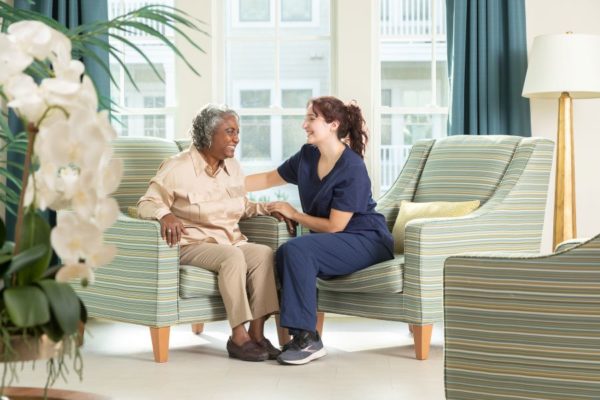Is My Loved One’s Home Safe?
For many families, the comfort of home is unmistakable—its familiar sights and sounds warm the heart. Home is where the pleasing aromas of your favorite meal invite anticipation, and as you settle into your place at the table, your shoulders soften and your mood brightens. It’s where you’ll find your loved one in their reading nook with a view as they pause to appreciate the sweet songbirds who cheerfully create the morning’s playlist. To your mom or dad, the family home holds memories and represents the care and sacrifice that went into making the space fit your family so well.
Understandably, conversations around keeping your parent(s) safe, whether at home or in a different living arrangement, may feel a bit heavy or emotional at first. It’s crucial to wade through the discomfort and have these discussions in advance. It’s also important to remember you’re on the same team and share that you are united in your goal of helping mom or dad maintain a lifestyle that brings them joy and peace.
As you embark on this journey together, we hope the information in today’s post serves as a helpful starting point. Keep reading for a few safety considerations for their home. We also recommend looking into the resources available from AARP, the National Institute on Aging, Health In Aging and others on this topic.
Location Matters More Than Ever
 You’re likely familiar with the importance of “Location, location, location!” in real estate. The location of your loved one’s residence is critical for this stage in their life. We recommend evaluating the location of their home from a different lens. Here are a few helpful questions to consider:
You’re likely familiar with the importance of “Location, location, location!” in real estate. The location of your loved one’s residence is critical for this stage in their life. We recommend evaluating the location of their home from a different lens. Here are a few helpful questions to consider:
- In the event of a medical emergency, how close is their home to a hospital or urgent care facility?
- In Should there be a fire in the home, is the fire department nearby?
- In Is getting my loved one to their doctor’s appointments manageable?
- In Does my loved one feel safe in their community?
- In How close to them (or you) are grocery stores, restaurants and other entertainment options?
- How does the quality of life rank for seniors in the state?
A Safe and Welcome Entry
Ease of entry into their home makes everyday life more manageable. Be aware that steps leading into the home pose a safety risk. Opting for a ramp with handrails makes getting inside easier, especially when using a scooter or wheelchair. Having one in place also helps reduce the likelihood of tripping or falling on steps. In a Consumer Affairs article about aging in place, Jonathan Trout writes, “Even if your parents don’t use a wheelchair, a ramp eliminates the need to navigate steps, which can make maintaining balance difficult, even with a banister.”
The width of the entryway matters; aim for at least three feet, and ideally more. Installing slip protection, adjusting threshold height when needed, adding protection from the elements, checking the slope and installing adequate lighting also impact the overall safety.
Getting Around
Evaluate the inside of the home with safety in mind. Elaine Howley for U.S. News & World Report writes, “A risk of falls is one of the primary safety concerns for seniors.” Howley also reminds readers: “Throw rugs, clutter on the floor and in walkways and items on the stairs can all be dangerous trip hazards.”
Pets also present unique challenges for aging loved ones, as they are often underfoot. Meghan Wentland’s recommendation on BobVila.com: “Crating or gating pets in a less central part of the home when elderly or older adults are present.” Wentland says doing so creates a “comfortable, secure home base” for furry friends and visitors to the home.
Ideally, in multi-level homes, the primary bedroom and bathroom are on the main level or can be relocated there. If the stairs must be used, chair lifts and handrails on both sides are an improvement; refer to the stairs and steps safety checklist from Health.com for more pointers.
Fire Hazards
Preparing a nourishing, home-cooked meal is a source of joy for the chef and their guests. The U.S. Fire Safety Administration’s Fire Safety for Older Adults walks readers through a handful of tips and reminders; be aware that “cooking fires are the number one cause of home fires.” The guide also contains facts and recommendations for keeping safe throughout the house, including heating the home, electrical safety, creating a fire escape plan and more. Additionally, investigate whether installing an automatic stove/oven control makes sense for your loved one.
In the Bathroom
Geraldine Orentas for The American College of Health Care Administrators reports, “While a slip and fall accident can happen anywhere around the house, the bathroom is by far the most dangerous room for them.” Common culprits for injuries include slippery floors, clutter, inadequate lighting and the lack of safety bars. Orentas also mentions installing, upgrading and checking safety devices in the bathroom; SafeWise goes into more detail and links to specific products.
In Case of Emergency
Ease of telephone access and having emergency phone numbers clearly posted will help ensure your loved one can reach out for help when needed. Be sure you are listed as an emergency contact on their cell phone as well. U.S. News & World Report covers a variety of medical alert systems, which may add an “extra layer of protection and oversight.”
Home Maintenance
A properly maintained home helps provide peace of mind for the family and keeps the property in good condition, protecting their investment. The Home Maintenance Checklist from AARP breaks tasks down by season. Consumer Affairs highlights a handful of monthly to-dos that will ensure everything is in working condition, including smoke detectors, carbon monoxide detectors, fire extinguishers and more. Knowing what needs to be done and creating a plan can be empowering. Should you notice tasks being neglected or feelings of overwhelm, invite your loved one to have a conversation so you can find a solution together.
A Place To Thrive
Ultimately, your loved one’s residence should enable them to be more independent as they lead a full life. Is their current home a hindrance, or is it allowing them to lead a vibrant life? The assisted living communities available through Liberty Senior Living are designed with the needs of older adults in mind; you’ll find everything from elevators to walk-in showers, call buttons, an around-the-clock nursing team, transportation and more. Additionally, mom or dad’s social, spiritual, intellectual and physical needs and overall wellness are taken into consideration with a bustling calendar of community events and outings. Time here is infused with a little luxury thanks to restaurant-style dining, personal laundry service, an on-site salon and barber, and WiFi, for starters.
Elevate Your Life
Liberty Senior Living, LLC, is a division of Liberty Healthcare Management that specializes in senior living and retirement communities. Based in North Carolina and established in 1875, Liberty Healthcare Management is an experienced, family-owned company that has been assisting people to manage their healthcare and residential needs for over 145 years. To learn more about Liberty Senior Living and the communities they offer, please visit www.LibertySeniorLiving.com .








